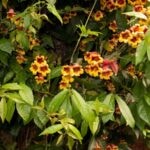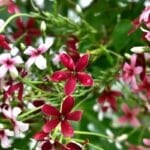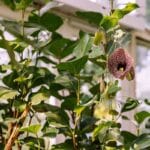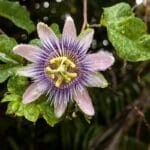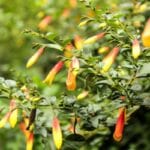Having a sturdy and versatile plant in a landscape will lessen the need for maintenance in the landscape. This is why the Asiatic jasmine is one of the good vines to be incorporated into most landscape designs.
As a vigorous grower, it produces alluring aesthetics, resistant to most environments, and requires minimal maintenance. Below is more in-depth information about the Asiatic jasmine and its common cultivars that will come in handy.
Botanical Information
The Trachelospermum asiaticum or Asiatic jasmine is also known as Asian jasmine, Asian star jasmine, yellow star jasmine, dwarf jasmine, star jasmine, and Asiatic jasmine.
Furthermore, this plant may also bear other common names depending on the country. Although, a common misconception about this plant is caused by it being called jasmine despite the lack of connection between it and the true jasmine plant.
The True jasmine belongs to the Oleaceae family while the Asiatic jasmine belongs to the Apocynaceae family.
Its genus is a combination of two Greek words – trachelos and sperma. The former means neck and the latter means seed. Moreover, its specific epithet is derived from its origins.
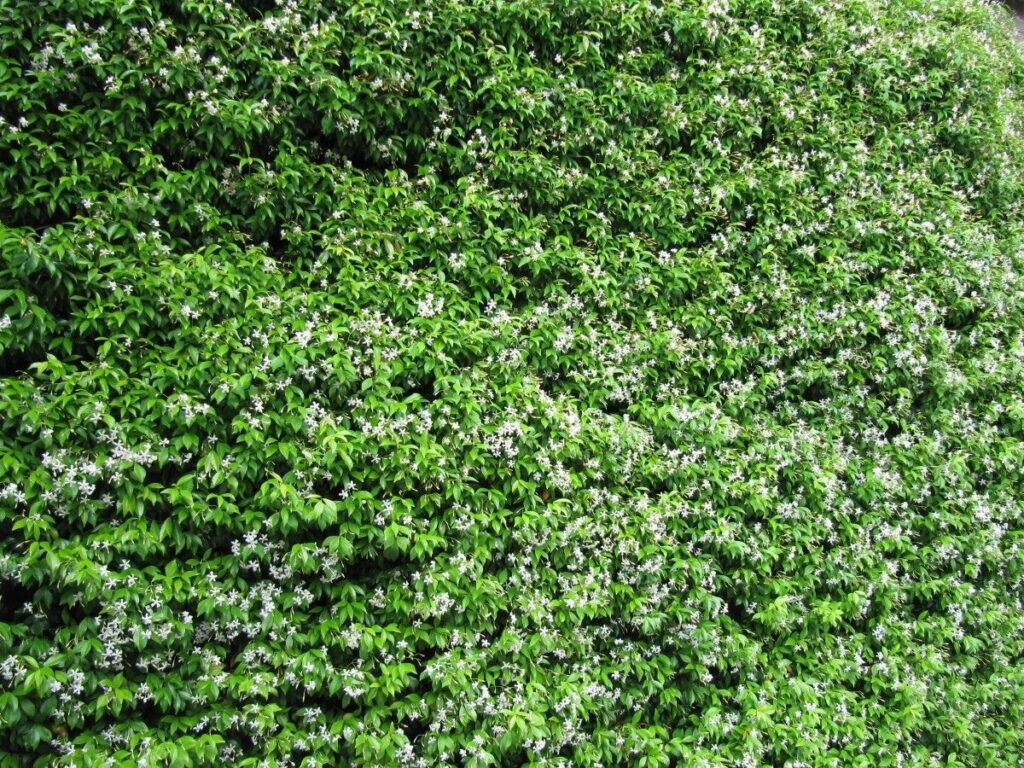
Spatial Distribution
Some of its common names give a hint on where this plant originated, which is in Asian countries such as Korea, Japan, India, and China. Given its origins, this plant thrives in USDA Zones 7 to 11.
Growth Habits
The Asian jasmine is an annual broadleaf that is widely cultivated to serve as a groundcover or vine in a landscape due to its vast growth and development.
Given its fast growth rate, it can extend up to 2 feet in height and 10 to 12 feet in width given that there are little to no supporting infrastructures present. In 10 years or so, this vine may grow up to more than 25 feet in height and width.
Aside from bearing leaves all year round, small and simply beautiful flowers are seen during May to June right before summer just in time for people to enjoy the outdoors.
Leaves
On regular days, the Asiatic jasmine bears green and waxy foliage. However, the leaves change their color to dull-brown and brick red at the onset of Fall.
Although, the plant’s simple oval shape and opposite leaf arrangement are retained. The same goes with its size which is usually around 1 to 3 inches in length.
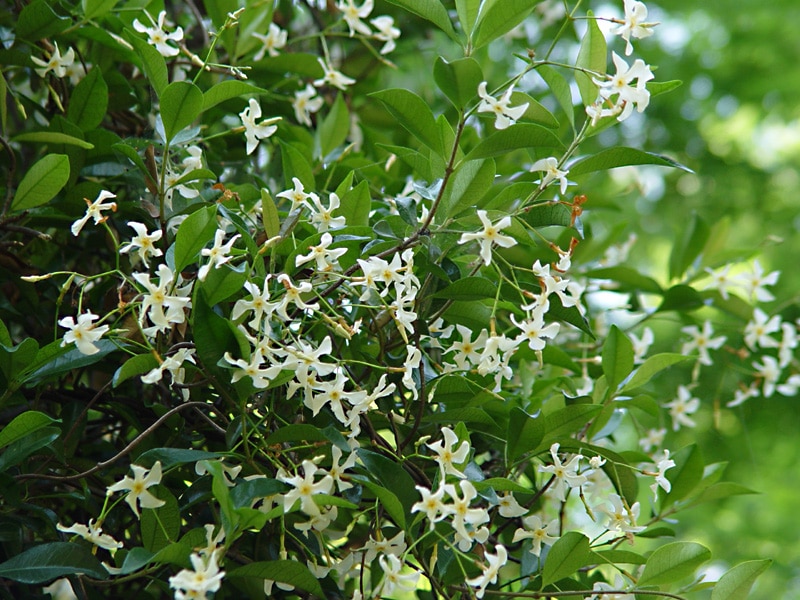
Flowers
The common name Asian Star jasmine describes what this plant’s flowers look like. Its color ranges from creamy white, yellow, tan, or gold. The small florets are known to have a star-like pinwheel shape with 4 to 5 petals.
Each floret forms a bundle of florets wherein one terminal flower will emerge followed by lateral blooms. Thanks to these characteristics, the star shaped flowers serve as an invitation for pollinators such as birds and insects. However, it is important to note that the Asian Star jasmine rarely blooms in Florida.
Fruit and Seeds
Eventually, after flowering, the vine reaches maturity and creates pods that bear seeds for reproduction.
How to grow asiatic jasmine
For someone to successfully asiatic jasmine care, it is important to know what the plant needs. A keen observation in combination with acquired knowledge about that plant will help solve potential problems that may arise in the landscape.
Below are the basic requirements to know how one can look after the Asian jasmine vine.
Sun Requirement
Because it is drought tolerant, the optimal growth of the Asiatic jasmine will be obtained if exposed to full sun. It should be uninterrupted and lasts for at least 6 hours daily. Although it also tolerates partial shade, the formation of pigment and production of flower buds may be problematic.
Water Requirement
Moderate amounts of water supplied frequently are enough for this vine to grow. However, in places wherein rain is prominent, watering may be done less frequently. On the other hand, watering should be done more frequently during extreme heat summer days.
If rainfall is happening often, less watering is needed. Regular watering should be done during the hotter months.
Temperature and Humidity
Asiatic jasmine (Trachelospermum asiaticum) thrives in a wide range of temperatures but prefers USDA hardiness zones 7 to 10.
While it is relatively resilient in various climates, Asiatic jasmine generally prefers moderate temperatures and can withstand high humidity levels, making it suitable for regions with warmer and more humid climates.
Soil Conditions
The Asian jasmine is a versatile vine as it can thrive in almost any soil as long as there is good drainage. Either sand, clay, or well drained soil are suitable for the vine.
Moreover, when planting in a pot, use a potting mix with a large water holding capacity to ensure healthy growth. Make sure that the pot has drain holes to prevent waterlogging .
Aside from the type of medium, the space needed is also to be considered since this vine is a fast grower. At least 3 feet by 6 feet planting space is enough for the vine to grow and bloom without disrupting other plants in the vicinity.
Fertilizer Requirement
Generally, the application of external fertilizer is not needed as long as the soil is rich in organic matter.
This might lead to soil toxicity. However, if the goal is to hasten the development of the Asiatic jasmine, the application of slow-release fertilizers for at most once a month may be done. Only do this when the vine is at its young stages.
Once established, the application of slow feeding fertilizer should be limited to once a year.
Common Pests & Plant Diseases
Asiatic jasmine is generally resistant to pests and diseases. However, it may occasionally face issues with aphids or scales, which can be managed with insecticidal soap or neem oil.
Additionally, root rot can be a concern if the soil is consistently waterlogged, emphasizing the importance of well-draining soil for the health of Asiatic jasmine plants. Regular monitoring and proper cultural practices contribute to keeping this ground cover thriving and disease-resistant.
Propagation
The Asiatic jasmine vine is propagated by planting semi-hardwood cuttings or by layering. In both ways of propagation, choosing stems that are mature and actively growing is necessary.
Also, the planting medium should have proper drainage and moisture. For the cuttings, dipping the cut end into rooting hormones aids in the formation of roots. When these low maintenance plants are ready to be transplanted, provide at least 1.5 feet apart per plant to ensure healthy new growth.s
Common Cultivars
‘Snow-N-Summer’
This cultivar is known to have beautiful foliage that changes its color from pink and white to dark green and white as the leaf matures. It also bears yellow showy flowers.
‘Variegatum’
This cultivar is characterized by variegated green leaves with white borders and speckles.
‘Winter Beauty’
Having copper-colored leaves during spring that changes into a deep green with white variegations for the succeeding months is what distinguishes this cultivar.
‘Goshiki’
One of the best characteristics of this cultivar is that it is sturdy even during winter. Its mature leaves are also distinguished by having a yellow base color with narrow green strips and deep green margins.
On the other hand, immature leaves are red-orange. Its flowers also change as it matures, from creamy-white to yellow.
‘Summer Sunset’
This cultivar loves to be in the sun more than the others, giving the landscape vibrant colors of yellow and green in one plant.
‘Long Leaf’
True to its name, this cultivar bears long deep green leaves throughout the year and creamy white flowers in growing season.
Function In The Landscape
As a fast-growing, versatile, and very little maintenance vine, the plants may be placed almost anywhere in the landscape. It can be grown in pots or hanging baskets and let trail down the same way as it would when placed in pergolas and roofs.
In some landscapes, it is incorporated into their vertical gardens wherein the vine is left to crawl and grow onto supporting structures. The Asian jasmine plant also loves to twine and cling on to fences and grids providing a screen for additional privacy in the landscape.
Furthermore, it is an excellent ground cover for mass plantings and turfgrass replacements. It is an ideal plant for landscaping as it can tolerate drought, shade, deer, and salt while attracting wildlife and adding eye-catching colors. The dense foliage of the Asian jasmine plant helps to suppress weed growth .
Potential Harm
While Asiatic jasmine is a resilient ground cover, it has the potential to become invasive in some regions. Its vigorous growth habit and ability to spread rapidly can lead to competition with native vegetation.
Gardeners should monitor and control its growth to prevent it from outcompeting other plants and becoming a potential threat to local ecosystems. Additionally, Asiatic jasmine can cause skin irritation in some individuals, so wearing gloves while handling it is advisable.
FAQs
Is Asiatic jasmine indoor or outdoor?
Asiatic jasmine (Trachelospermum asiaticum) is typically grown as an outdoor plant. While it can be grown indoors in containers, it is well-suited for outdoor landscapes.
Where is the best place to plant Asiatic jasmine?
The best place to plant Asiatic jasmine is in well-drained, moist soil with partial to full sunlight. It is often used as ground cover, but it can also be planted along fences, trellises, or as a climbing vine.
Will Asiatic jasmine climb?
Asiatic jasmine is a ground cover plant and does not naturally climb like some other jasmine species. It spreads horizontally and is commonly used to cover large areas of the ground.
What is the difference between jasmine and Asiatic jasmine?
The main difference between jasmine and Asiatic jasmine lies in their botanical classification and growth habits. True jasmine belongs to the genus Jasminum and is known for its fragrant flowers. Asiatic jasmine, on the other hand, is a ground cover plant (Trachelospermum asiaticum) and is not botanically related to true jasmine. It is valued for its dense, low growing conditions and is often chosen for its ability to cover and adorn landscapes with its evergreen foliage.
Final thoughts
By adhering to the Asiatic jasmine care tips outlined in this article, you’ll equip your plant with the optimal environment and nourishment it craves.
Remember, the key to success lies in providing adequate sunlight, well-draining soil, and regular watering, along with occasional pruning and pest control. With a little dedication to these Asiatic jasmine care routines, you’ll cultivate a thriving oasis of beauty and fragrance in your own home.

